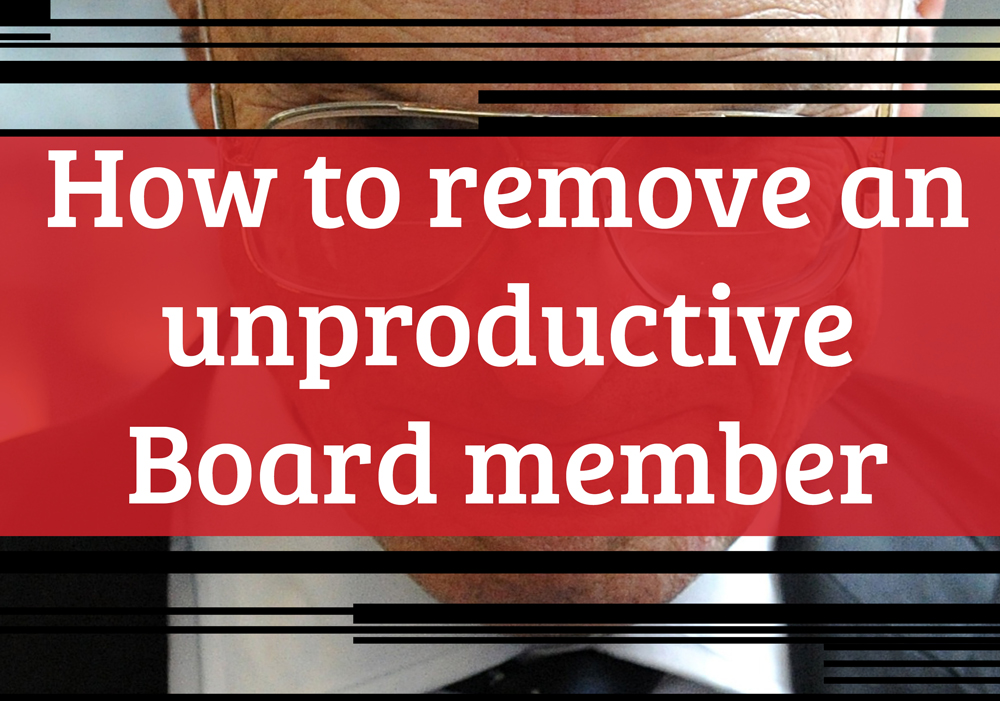There are a number of ways that a Director can be removed from a Board, but each needs to be carefully considered for its relevance to your situation.
Removing a Director should occur either by performance management (e.g. Board evaluation results), structural management (e.g. term limits or constitutional and/or legal requirements invoked), or by perception management (e.g. offering a position on an advisory committee)
Let's take a look at a few strategies that are available to you.
Performance Management Strategies
High expectations from the beginning
Even before a Board member begins their term, the high expectations of the Board should be presented and discussed with the potential Board member. This can be done through a Board Charter, or Standards of Behavior document. If the Board member is then not meeting these expectations, then they are counseled and invited to change or resign.
Role of the Governance subcommittee
Develop a Governance (or CEO/Board Evaluation) subcommittee of the Board. It is common for the Chair to be on this Committee, and quite often they Chair this subcommittee as well. This subcommittee is responsible for both the Board and CEO succession planning, performance management, and evaluation. These responsibilities should not be vested in the Chair alone. This is the forum for asking a Director to resign because of non-performance issues.
Board evaluation
Conduct Board evaluations, where Directors rate themselves, the Board and their fellow Directors. This helps in identifying non-performing directors, and presents the opportunity to provide peer advice to that director. You can also ask fellow Directors the question: “should this Director be encouraged to seek another term on the Board”. These individual results can then be discussed with the concerned Director by the Chair or the Governance Committee. It is not unheard of for non-performing directors to resign rather than be subject to a Board evaluation process.
Personal Goal setting
Ask each Director to write down their two or three personal goals for the upcoming year, and how they will enhance the work of the Board. The Chair or the Governance Committee can then review these personal goals every six months with the Director concerned.
Structural Strategies
Term limits
Many organizations have specified term limits for Board Directors with the aim to diminish the concentration of power in a small number of individuals and to weed out inactive or difficult board members.
These term limits are usually 2x2x2 (total of 6 years) or 3x3x3 (total of 9 years). Some have separate term limits for Officer positions (Chair, Treasurer etc) which effectively extends the possible terms.
Be very clear, however, that term limits don’t automatically guarantee that Board members will get to serve each and every term possible under term limit rules. It’s not an entitlement. Therefore, if the Governance Committee doesn’t feel that someone who is coming up for re-appointment to a second or third term is the right “fit”, they can recommend that the Board member be thanked for their service and be encouraged to not nominate for re-election.
Some organizations include a clause that specifies time limits, with an extra sentence that states something like “or as otherwise decided by the Board”, to allow high performing Board members to remain.
Constitution
Most constitutions have a clause that specifies the conditions under which a Director is deemed to have resigned or is required to resign. These include provisions such as:
Being absent from three Board meetings consecutively without the approval of the Board;
Becoming of unsound mind;
Failing to declare an interest in a contract with the company;
Holding any other office of profit under the company (except that of managing director) without the consent of the company in general meeting;
Being automatically disqualified from managing a corporation due to, for example, being convicted of an offence relating to the business or financial standing of the company;
Being disqualified by the regulator or being disqualified via a court order;
Becoming bankrupt;
Removal by resolution in a general meeting;
Death
In Australia, members can remove a director by resolution but the board or other directors cannot remove a director. In the USA, it is possible to have clauses that specify the conditions under which the Board can remove Directors. It is slightly different in each country, and you need to study the specific legislative details for this area.
In-camera session of Board meeting
Develop in-camera sessions of the Board, where the Board meet without any staff, and performance management of a particular Director can be discussed without staff present. These are often every two or three Board meetings, often at the end of the meeting.
Free Download: Board Member Expectation Worksheet
Use this worksheet as a reminder of the expectations which all Board members have agreed to meet.
Perception Management Strategies
Advisory Committee/Council. (e.g. historian, policy advisory group)
This possibility is offered to someone who has done a great job in the past, but no longer has the skills to provide what the organization needs today. They are still part of the loop of relevant information, and are treated as “special”, because they are. The key here is that once they voluntarily step down from the Board, they are given a meaningful role.
Patron
This is often used to recognize a founder, or someone who has been influential in the formation and direction of the organization, but who is not suitable for a Board position. Some organizations have created the position of “Life Ambassador” or similar title, in recognition of the outstanding contribution that person has made.
Skills analysis for re-election
This strategy is good practice whether you have a non-performing Board member or not. Identify the skills that the Board requires over the next three years, ask each Director coming up for election or re-election to provide a short summary of how they meet these skills, and provide these summaries to those who vote for the Director positions, with details on what skills the Board requires.
To avoid facilitating the removal of a non-performing director, the following three components should be considered:
Review your Board member selection process. If the screening process for the appointment of new directors is effective most of these problems should be avoided.
Review your Board induction process. Ensure incoming Board members truly understand the high expectations the Board has, the performance management regime, and the consequences of non-performance.
Review your Board performance management processes. The best time to introduce these performance management strategies is when they are not needed. If they are needed, then introduce them on a progressive basis.
What other strategies have your used to effectively and respectfully remove an unproductive Board member? Share your experiences in the comments below.


